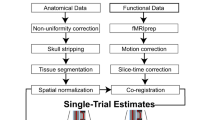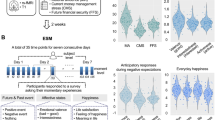Abstract
Although global declines in structure have been documented in the aging human brain, little is known about the functional integrity of the striatum and prefrontal cortex in older adults during incentive processing. We used event-related functional magnetic resonance imaging to determine whether younger and older adults differed in both self-reported and neural responsiveness to anticipated monetary gains and losses. The present study provides evidence for intact striatal and insular activation during gain anticipation with age, but shows a relative reduction in activation during loss anticipation. These findings suggest that there is an asymmetry in the processing of gains and losses in older adults that may have implications for decision-making.
This is a preview of subscription content, access via your institution
Access options
Subscribe to this journal
Receive 12 print issues and online access
$209.00 per year
only $17.42 per issue
Buy this article
- Purchase on Springer Link
- Instant access to full article PDF
Prices may be subject to local taxes which are calculated during checkout




Similar content being viewed by others
Change history
13 August 2007
In the version of this article initially published, the first author’s name was incorrect. The first author’s name should be Gregory R Samanez-Larkin. The error has been corrected in the HTML and PDF versions of the article.
Notes
*NOTE: In the version of this article initially published, the first author’s name was incorrect. The first author’s name should be Gregory R Samanez-Larkin. The error has been corrected in the HTML and PDF versions of the article.
References
Park, D.C. & Schwarz, N. (eds.). Cognitive Aging: A Primer (Psychology Press/Taylor & Francis, Philadelphia, 2000).
Cabeza, R., Nyberg, L. & Park, D. Cognitive Neuroscience of Aging: Linking Cognitive and Cerebral Aging (Oxford University Press, New York, 2005).
Carstensen, L.L., Mikels, J.A. & Mather, M. Aging and the intersection of cognition, motivation and emotion. in Handbook of the Psychology of Aging (eds. Birren, J.E. & Schaie, K.W.) 343–362 (Academic Press, San Diego, 2005).
Carstensen, L.L. The influence of a sense of time on human development. Science 312, 1913–1915 (2006).
Mather, M. & Carstensen, L.L. Aging and motivated cognition: the positivity effect in attention and memory. Trends Cogn. Sci. 9, 496–502 (2005).
Knight, M. & Mather, M. The affective neuroscience of aging and its implications for cognition. in The Biological Bases of Personality and Individual Differences (ed. Canli, T.) 159–183 (Guilford Press, New York, 2006).
Mather, M. et al. Amygdala responses to emotionally valenced stimuli in older and younger adults. Psychol. Sci. 15, 259–263 (2004).
Marschner, A. et al. Reward-based decision-making and aging. Brain Res. Bull. 67, 382–390 (2005).
Backman, L. et al. Age-related cognitive deficits mediated by changes in the striatal dopamine system. Am. J. Psychiatry 157, 635–637 (2000).
Kaasinen, V. et al. Age-related dopamine D2/D3 receptor loss in extrastriatal regions of the human brain. Neurobiol. Aging 21, 683–688 (2000).
Raz, N. The aging brain observed in vivo: Differential changes and their modifiers. in Cognitive Neuroscience of Aging: Linking Cognitive and Cerebral Aging (eds. Cabeza, R., Nyberg, L. & Park, D.) 19–57 (Oxford University Press, New York, 2005).
Volkow, N.D. et al. Association between decline in brain dopamine with age and cognitive and motor impairment in healthy individuals. Am. J. Psychiatry 155, 344–349 (1998).
Knutson, B., Westdorp, A., Kaiser, E. & Hommer, D. fMRI visualization of brain activity during a monetary incentive delay task. Neuroimage 12, 20–27 (2000).
Knutson, B., Adams, C.M., Fong, G.W. & Hommer, D. Anticipation of increasing monetary reward selectively recruits nucleus accumbens. J. Neurosci. 21, RC159 (2001).
Bjork, J.M. et al. Incentive-elicited brain activation in adolescents: similarities and differences from young adults. J. Neurosci. 24, 1793–1802 (2004).
Carstensen, L.L., Pasupathi, M., Mayr, U. & Nesselroade, J.R. Emotional experience in everyday life across the adult life span. J. Pers. Soc. Psychol. 79, 644–655 (2000).
Garavan, H., Hester, R., Murphy, K., Fassbender, C. & Kelly, C. Individual differences in the functional neuroanatomy of inhibitory control. Brain Res. 1105, 130–142 (2006).
Carstensen, L.L. & Mikels, J.A. At the intersection of emotion and cognition: aging and the positivity effect. Curr. Dir. Psychol. Sci. 14, 117–121 (2005).
Kisley, M.A., Wood, S. & Burrows, C.L. Looking at the sunny side of life: age-related change in an event-related potential measure of the negativity bias. Psychol. Sci. (in the press).
Wood, S. & Kisely, M.A. The negativity bias is eliminated in older adults: age related reduction in event related brain potentials associated with evaluative categorization. Psychol. Aging 21, 815–820 (2006).
Kim, H., Shimojo, S. & O'Doherty, J.P. Is avoiding an aversive outcome rewarding? Neural substrates of avoidance learning in the human brain. PLoS Biol. 4, 1453–1461 (2006).
Denburg, N.L., Recknor, E.C., Bechara, A. & Tranel, D. Psychophysiological anticipation of positive outcomes promotes advantageous decision-making in normal older persons. Int. J. Psychophysiol. 61, 19–25 (2006).
Denburg, N.L., Tranel, D. & Bechara, A. The ability to decide advantageously declines prematurely in some normal older persons. Neuropsychologia 43, 1099–1106 (2005).
Knutson, B., Fong, G.W., Bennett, S.M., Adams, C.S. & Hommer, D. A region of mesial prefrontal cortex tracks monetarily rewarding outcomes: characterization with rapid event-related fMRI. Neuroimage 18, 263–272 (2003).
Knutson, B., Taylor, J., Kaufman, M., Peterson, R. & Glover, G.H. Distributed neural representation of expected value. J. Neurosci. 25, 4806–4812 (2005).
Glover, G.H. & Law, C.S. Spiral-in/out BOLD fMRI for increased SNR and reduced susceptibility artifacts. Magn. Reson. Med. 46, 515–522 (2001).
Cox, R.W. AFNI: software for analysis and visualization of functional magnetic resonance neuroimages. Comput. Biomed. Res. 29, 162–173 (1996).
Neter, J., Kutner, M.H., Nachtsheim, C.J. & Wasserman, W. Applied Linear Statistical Models (Irwin, Chicago, 1996).
Cohen, M.S. Parametric analysis of fMRI data using linear systems methods. Neuroimage 6, 93–103 (1997).
Kuhnen, C.M. & Knutson, B. The neural basis of financial risk-taking. Neuron 47, 763–770 (2005).
Gazzaley, A. & D'Esposito, M. BOLD functional MRI and cognitive aging. in Cognitive Neuroscience of Aging: Linking Cognitive and Cerebral Aging (eds. Cabeza, R., Nyberg, L. & Park, D.) 107–131 (Oxford University Press, New York, 2005).
Acknowledgements
We would like to thank G.E. Wimmer and N.G. Hollon for assistance with data collection. This research was supported by US National Institute on Aging Research Grant AG008816, Center on the Demography and Economics of Health and Aging grant AG017253 and Center on Advancing Decision Making in Aging grant AG024957.
Author information
Authors and Affiliations
Contributions
G.S.L., S.G., L.N., L.C. and B.K. designed the experiment. G.S.L., S.G. and K.K. collected and analyzed the data. All of the authors contributed to the preparation of the manuscript.
Corresponding author
Ethics declarations
Competing interests
The authors declare no competing financial interests.
Supplementary information
Supplementary Fig. 1
Post-task cue ratings. (PDF 524 kb)
Supplementary Fig. 2
Gain versus nongain anticipation contrast maps for younger adults and older adults. (PDF 4575 kb)
Supplementary Fig. 3
Loss versus nonloss anticipation contrast maps for younger adults and older adults. (PDF 4429 kb)
Supplementary Fig. 4
BOLD activation extracted from the ventral striatum at anticipation. (PDF 495 kb)
Supplementary Fig. 5
Time courses of activation during anticipation of gain and loss in right ventral striatum. (PDF 654 kb)
Supplementary Fig. 6
Correlations between self-reported affect and brain activation. (PDF 616 kb)
Supplementary Fig. 7
Correlations between self-reported affect and brain activation. (PDF 627 kb)
Supplementary Fig. 8
Time courses of activation during anticipation of gain and loss in left medial caudate. (PDF 651 kb)
Supplementary Fig. 9
Time courses of activation during anticipation of gain and loss in right anterior insula. (PDF 651 kb)
Supplementary Fig. 10
Gain versus nongain outcome contrast maps for younger adults and older adults. (PDF 8582 kb)
Supplementary Fig. 11
Time courses of activation during outcome in left MPFC. (PDF 636 kb)
Supplementary Fig. 12
Time courses of activation during outcome in right ventral striatum. (PDF 639 kb)
Supplementary Fig. 13
MIL task performance. (PDF 582 kb)
Supplementary Fig. 14
MIL task performance over time. (PDF 518 kb)
Supplementary Fig. 15
Time courses of activation from individual participants extracted from voxels in primary visual cortex during a visual localizer task. (PDF 503 kb)
Supplementary Fig. 16
MID task schematic. (PDF 2558 kb)
Supplementary Fig. 17
MIL task schematic. (PDF 1904 kb)
Supplementary Table 1
Group maps for younger adults and older adults. (PDF 64 kb)
Supplementary Table 2
Comparison of older versus younger adults. (PDF 36 kb)
Supplementary Table 3
Monetary incentive learning (MIL) task performance. (PDF 32 kb)
Supplementary Table 4
Demographics, questionnaire data and cognitive test battery results. (PDF 40 kb)
Supplementary Table 5
Placement of 6-mm-diameter VOI spheres. (PDF 45 kb)
Supplementary Discussion
Study 1. (PDF 67 kb)
Supplementary Methods
Study 1. (PDF 103 kb)
Supplementary Results
Study 1. (PDF 143 kb)
Rights and permissions
About this article
Cite this article
Samanez-Larkin, G., Gibbs, S., Khanna, K. et al. Anticipation of monetary gain but not loss in healthy older adults. Nat Neurosci 10, 787–791 (2007). https://doi.org/10.1038/nn1894
Received:
Accepted:
Published:
Issue Date:
DOI: https://doi.org/10.1038/nn1894
This article is cited by
-
Circadian, Reward, and Emotion Systems in Teens prospective longitudinal study: protocol overview of an integrative reward-circadian rhythm model of first onset of bipolar spectrum disorder in adolescence
BMC Psychiatry (2023)
-
The effect of loss incentives on prospective memory in healthy older adults: study protocol of a randomized controlled trial using ultra-high field fMRI
BMC Psychiatry (2023)
-
A mesocorticolimbic signature of pleasure in the human brain
Nature Human Behaviour (2023)
-
Older adults process the probability of winning sooner but weigh it less during lottery decisions
Scientific Reports (2022)
-
Influences of dopaminergic system dysfunction on late-life depression
Molecular Psychiatry (2022)



